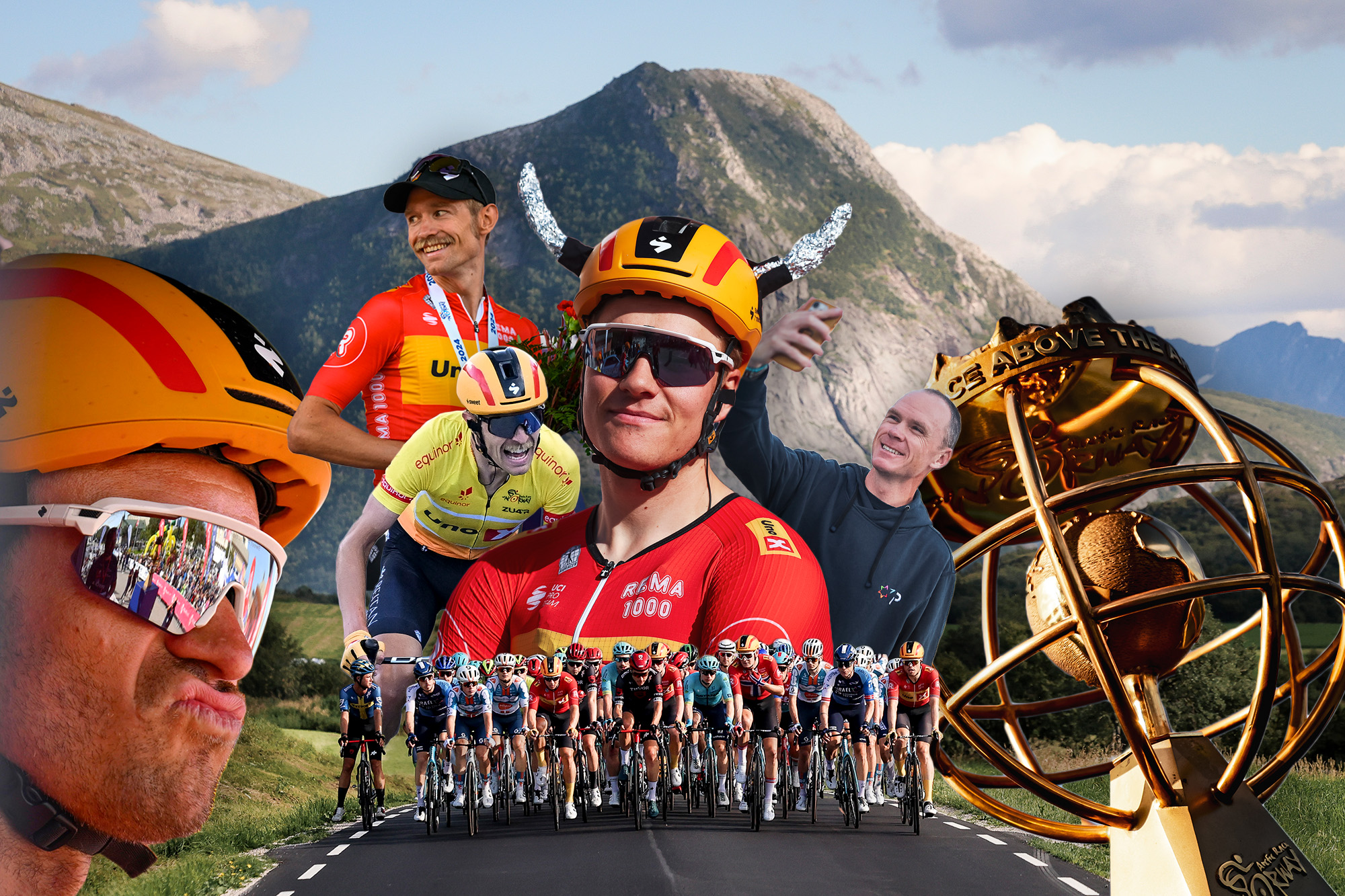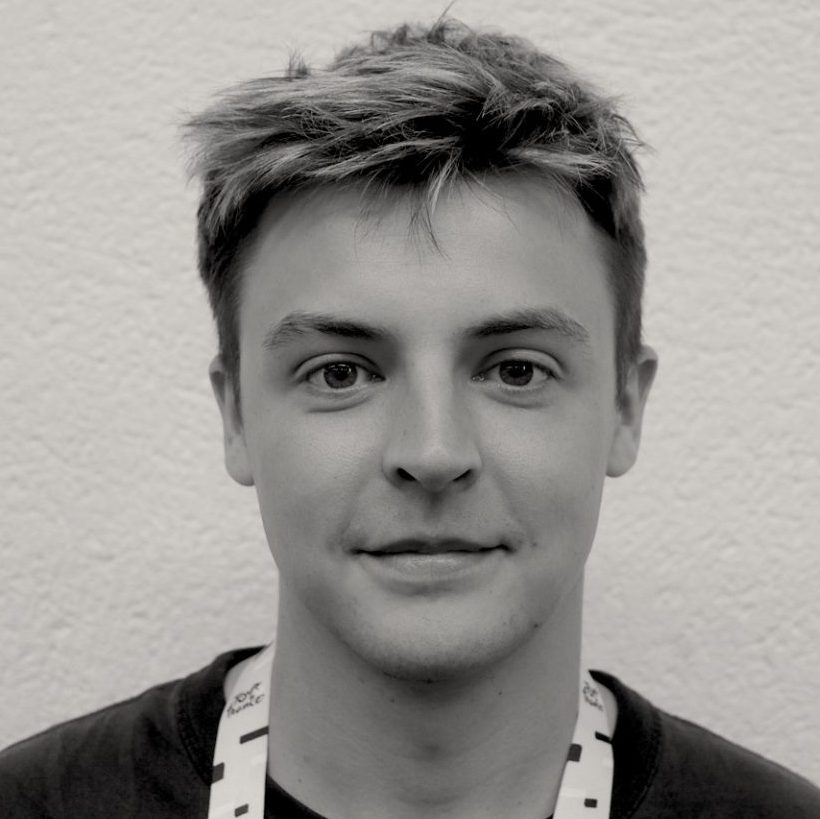I’ve been sitting on my luggage in a queue in departures, knees drawn up so they’re nearly in line with my shoulders, hands grasping my phone and earphones blocking an outside world filled with passengers so angry they want to watch the world burn.
Remco Evenepoel has just clambered off his bike, Eiffel Tower in the background, and held it above his head in absolute victory. A remarkable scene.
I look up from my phone and am in the exact same spot I was six hours ago when I first tuned in to the men’s Olympic road race. Since then, I’ve checked in for a flight, gone through security, been on a plane that’s sat on the runway for three hours, disembarked that plane still in London and now returned to the original check-in desk with the hundreds of other passengers trying to make their way to Oslo.
As the podium ceremony unfurls, I finally get to the front of the queue to be greeted by a sheepish young man who works neither for the airline I’m travelling with, nor the airport I’m at, but an intermediary set up presumably as the conduit for all passenger-based bollockings. He offers me a replacement flight that will get me to my final destination, the Norwegian city of Bodø, 48 hours after I originally planned, a coach journey with my fellow not-so-chipper passengers to a night at a hotel in the middle of nowhere, and an £8 food voucher by way of an apology.
Maybe it’s the complete futility of the situation, maybe it’s the contemptuous rage of the hundred other people who were supposed to already be in Norway by now, who’ve missed the starts of expensive holidays or long-planned family gatherings, that my being late to a press trip pales in comparison in the outrage scale. Maybe it’s because I’ve spent the past six hours watching an absorbing bike race and am still processing it, enjoying the afterglow of its adrenaline.
I leave the airport, retracing the steps I took many hours ago, ready to do it all over again for the third time the next day.

Finally, after some wrangling from powers over my head, I arrive only 24 hours later than expected. I look out of the plane window as we land and there are mountains rising straight up out of the water, nothing but Norwegian sea lapping at craggy, vertical rock.
At 67° north, a full degree of latitude into the Arctic Circle, it is 10PM and still light out, a sort of 6PM haze setting in. Bodø is as deserted as you’d expect on a Sunday night as I travel the short distance from the small airport to the hotel at the centre of town. Houses painted in bright primary colours line the streets of a micro-suburbia outside of this town of some 40,000 people, hemmed in by picket fences and structured by straight, sensible grid-system roads. Everything looks as if it had been tidily packed away ready for the start of another week.

Usually, with these sorts of press trips where you are flown, fed and housed on the dime of the race organiser (this time, the Tour de France’s Amaury Sport Organisation), they are paying for you to be here because they themselves are being paid to organise the race in question. They therefore need to show they are delivering exposure to whichever – usually state-adjacent – backer is funding everything. This, thankfully, brings international media into the fold, because the international media would not come if they had to pay.
Often, this is because the race is a smaller one, lacking huge, narrative-shifting sporting intrigue, or is located somewhere a lot of people don’t necessarily (rightly or wrongly) have at the top of their travel bucket lists.
The Arctic Race of Norway’s fault is its location in the calendar, right after the Tour de France and – this year – slap-bang in the middle of the Olympics too. Really, any journalist worth their salt is at either or both, and in between is too frazzled for a four-day sojourn in Norway. But my colleague Iain Treloar is in Norway already for the summer, and he’s up for an Arctic adventure where he can share the richness and quirks of his wife’s homeland with a newcomer.
With me being a freeloader, and this clearly highlighted to hotel staff with my name on its own special list, I am given a key to a hotel room with a window that when you pull back to the curtain shows a concrete wall less than 2 centimetres away, providing the relief of true darkness, away from the confusion downstairs where it’s still light outside but everyone has gone to bed.
The breakfast buffet is rammed, busier than any regular breakfast buffet, which usually has that regular silent dual soundtrack of awkwardness and solemnity. But here, Norwegians are quietly charging around, loading their plates with cheeses, breads, fruits, all excited for their days ahead.
Iain sits down to let me know what I missed on day one: him falling asleep on our media bus and drooling on himself, and how in the press room post-stage after Alexander Kristoff had sprinted to victory, the race broadcast abruptly cut to a news channel that took no time in flinging images of the British riots and devastation in Palestine.
He asks about the riots, in a concerned way I imagine Americans get asked about their political situation, but I’ve just been watching it on the news, same as him. In the lift back upstairs before we head out for stage 2, we are accompanied by our other colleagues of The International Media, who as I get off at my floor ask Iain if he’s going to sleep again today, chuckling to themselves.
The small media bus pulls up outside the hotel, its air con a respite from the 27°C / 81°F being experienced above the Arctic Circle today. Its driver, Erik, is sat ready, a grin on his face, and we make our way past mountains, fjords, hamlets and homesteads towards the stage 2 start in Beiarn, population: 1,027.
Unlike the Tour de France, where everywhere it is possible to move because it’s so very tightly controlled, with hulking team buses organised into strict paddocks and security and police everywhere you look, stage 2 of the Arctic Race of Norway has more of a village-fête feel.
Small marquees have been erected along the barriers between where the majority of teams are parked up and the official start line, with local brands doing small sponsor activations and middle-aged women handing out liquorice sweets and dancing uninhibitedly to the soft rock being blared out of the loudspeaker system.
Sat against the front-left wheel arch of Israel-Premier Tech’s race-supplied small people carrier, in lieu of the usual huge buses that trundle around after the bike racers they transport, is Chris Froome. He is texting, and putting his socks on, clearly in the earliest stages of getting dressed for a bike race. He is silent, being left alone. That is, until we spot him, and Iain wants to go and ask him what is in the huge, non-team issue satchel he’s been carrying around for the past couple of days.

Froome, 39, winner of multiple Tours de France and everything else, is wary when we ask if he’s got a second to chat, but relaxes when he realises we’re not here to re-tread the well-worn paths of what else he has left to do in this sport or his (rumoured) €6 million a year contract that still has a year to run, much to the displeasure of team owner Sylvan Adams, nor ask any spikier questions relating to his team’s sponsor.
We chitchat about how he’s always carried his own personal Sharpie pen for autographs (to be fair, imagine the germs!) and also how he chose to spend the two hours on the drive here: “E-mails,” he answers with an exhale. Just regular job stuff then for a multi-millionaire champion cyclist, the same somewhat-exasperated look behind his eyes that says he’s just someone else having to put up with the bullshit minutiae of their day.
It’s liberating, to see the lethargy of another in real time. At this point in the cycling season, the comedown from the Tour, the Giro, the Classics, has reached the floor. A summer of being too close to the bike racing oven often leaves you burnt out by cynicism from taking various peeks behind the curtain, hearing whispers on the wind, and seeing the sport in its true, humanly fallible way, instead of this imagined version that doesn’t exist, held up by viewers at home or on the other sides of barriers, who want to pretend it has a purity that is missing from the rest of the world, expressing magnificent human feats of courage, strength and hard work being richly rewarded.
A trip to Norway for a bike race is a chance to see something more real: bike racers less guarded, just regular, hardworking folk who by being extremely good at exercise has led them to this exact point. The point is to practice gratitude in seeing somewhere you never otherwise would outside of this line of work, to breathe renewed excitement into something one loves, to contemplate rather than react, to stop for one second and absorb. To admire and think more deeply for once.
Over at the Tietema-Unibet team, where there’s not a single adult to be found, Jelle Johannink, the eventual KOM victor and winner of 500 kg of salmon, is struggling with his stick-on numbers until a teammate shows him that you partially remove the backing and then slide it straight onto the jersey. Each team encampment has a relaxed feel, even though there are undoubtedly riders present experiencing their own individual struggles, simply clocking in and putting a brave face on things.

The riders lazily set off, and back in the van we pass Norwegian houses with barely a neighbour in sight, just an increasing gradient of green mountain out the back and sprawling, glistening fjord in front. What do the people who live here do on a regular day? Do you just take in the natural beauty over coffee in the morning before heading out for a brief kayak or whatever before heading back inside to once again stare at the same view you could never tire of looking at? Sounds alright to me.
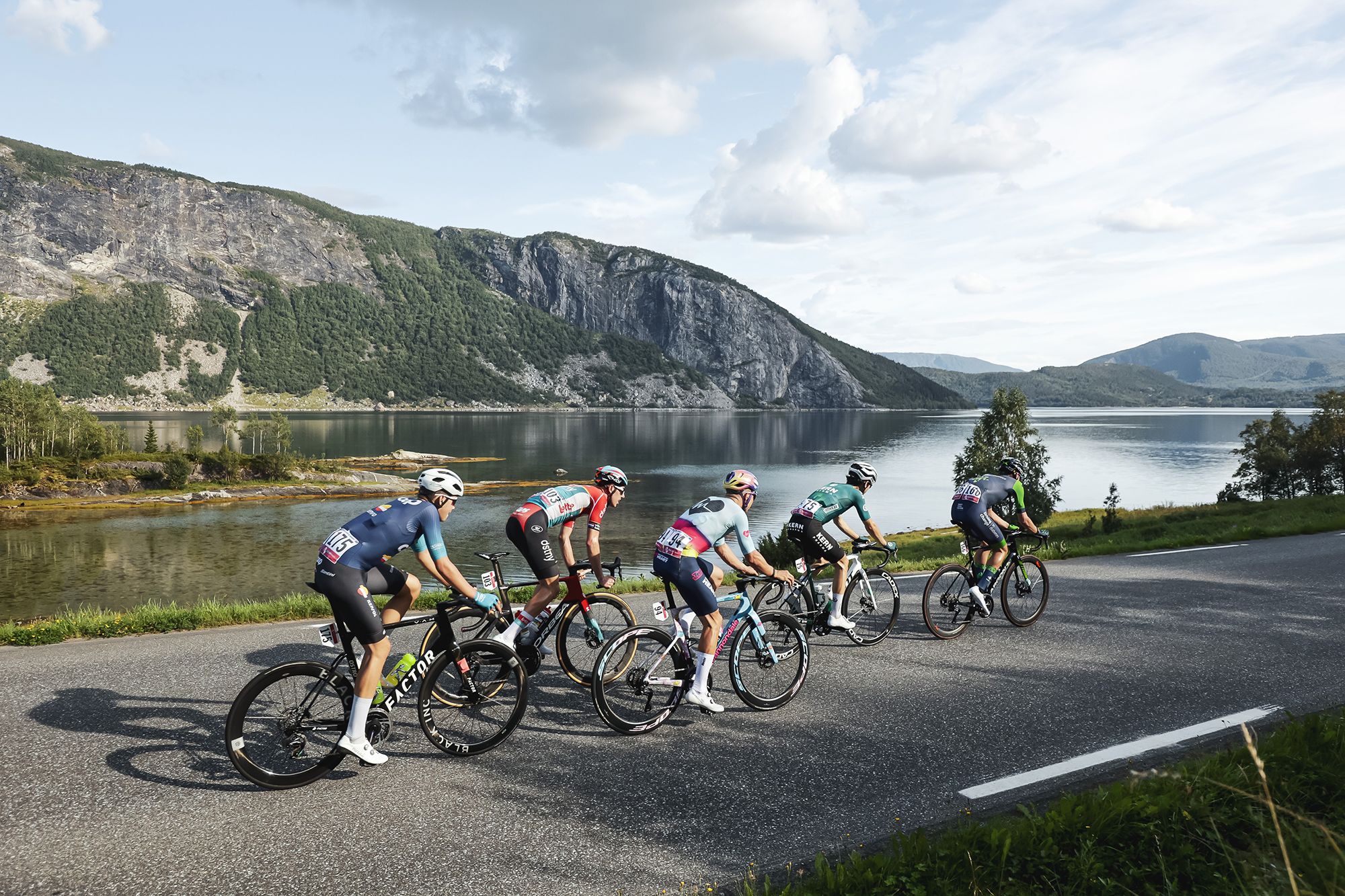
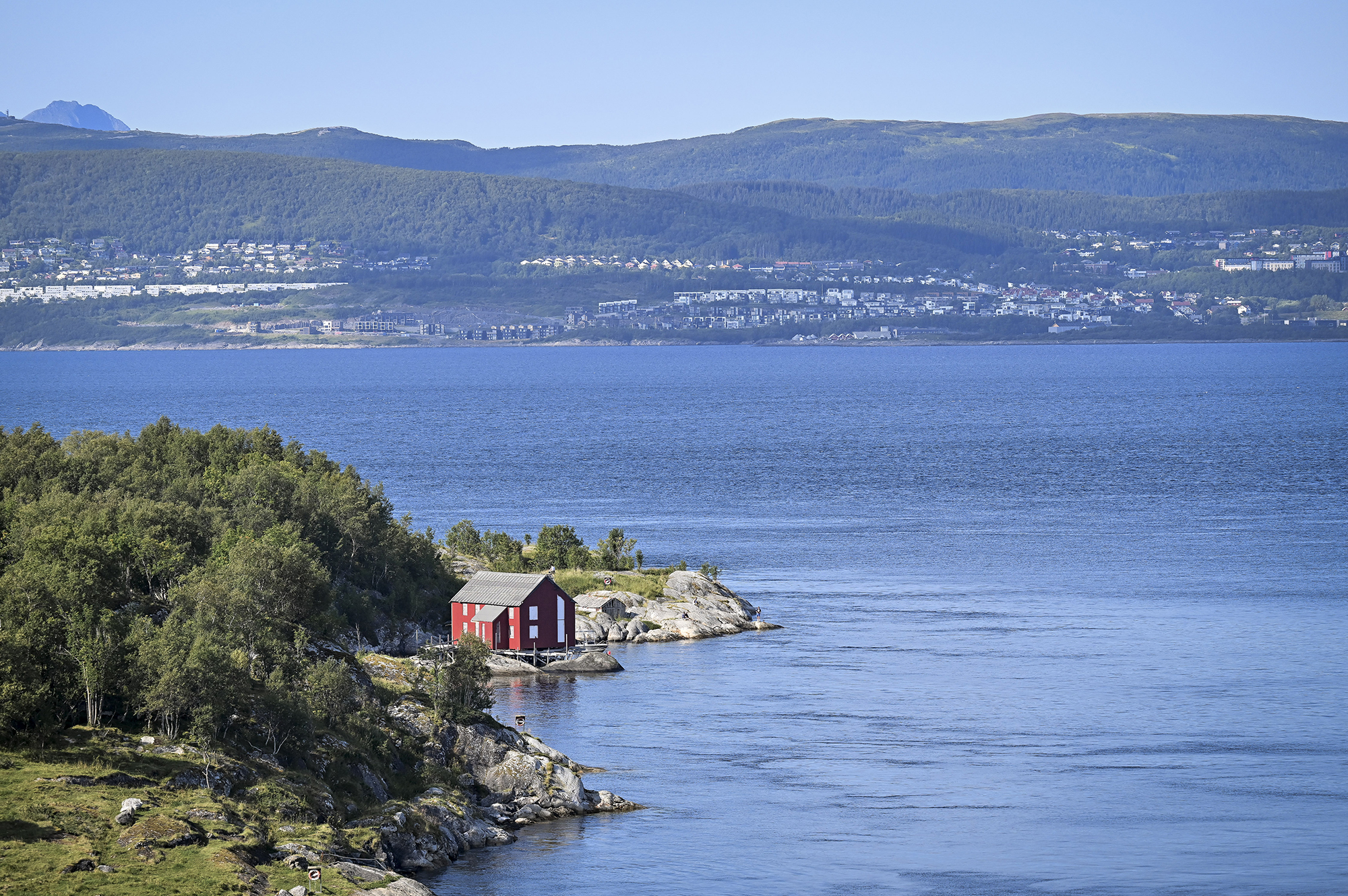
There are fans on the roadside as we head to the first categorised climb of the day to watch the riders go past, which is usually a rarity for races that provide press trips. Normally, mid-stage drives are accompanied by barren miles, highways in the midst of being built, uninterrupted nothingness. But the Arctic Race seems to be in rude health, a focal point for the already outdoorsy orientation of the average Norwegian. You get the sense this summer heat and daylight is cherished deeply, with not a drop wasted.
We arrive at the long, straight road of the categorised climb and pass a quartet of fans requiring attention. They had come across the border from Sweden, and brought with them whatever fancy dress they’d managed to scavenge from around the house, supplemented by Norwegian flags to celebrate the race. Here, flags and patriotism feels more tasteful, more like a celebration of what is collectively possessed, rather than a statement of bragging superiority.

Across the way, we spot some sheep, and with half an hour until the riders arrive, we scamper over boggy ground to try and meet the flock. Iain stops along the way, plucking a couple of blueberries off the ground and popping them in his mouth without a second thought.
“Are … are you sure you can eat them?” I ask.
“Yeah, of course,” he responds matter of factly.
I’m not convinced: “How do you know they’re not poisonous?”
“Everyone here eats wild berries,” Iain assures me.
I do not eat the berries … but should I be eating the berries? Is eating berries off the floor what I’m lacking? Does eating the berries off the floor make everything better?
As the riders approach, signalled by the increase in race vehicle traffic, we wander back to the road, to make small talk with bus driver Erik and Jørgen, a part-time student, part-time journalist, who in this socially democratic haven is paid to do both of those things simultaneously.
Erik explains how when he’s not driving our bus, he’s working on the 2029 Alpine World Ski Championships, which he successfully campaigned to bring to his hometown of Narvik, a town which lies even farther north than where we are now. As necessitates the act of small talk, we discuss how great the weather is, and Erik says it’s been like this – sunny, warm – for two summers now, but that that’s not the important thing; what’s important is that at the same time it’s been raining in the south of the country.
Erik laughs, heartily, and Jørgen nods in agreement, smiling. Why is it so important that your compatriots in the south are not having as nice summers as you are? “South people complain too much,” Erik says. The riders have arrived, and while the leading breakaway quartet sprint for the points at the summit, the peloton passes nonchalantly, quiet without the fans save for a few muffled conversations eking out of the mass of Lycra and clanking gears.
At the finish line in Fauske (population: 9,572), we go to a garage so Iain can introduce me to ‘softis’ – soft-serve ice cream, but proper, dairy ice cream (the Norwegians pride themselves on their dairy-based superiority, apparently) which is then dunked in a vat of small, flavoured balls of your choosing. The woman serving me loses the entire ice cream in the yellow tutti frutti vat, and wordlessly, showing zero annoyance, scoops it out and repeats the process.
We sit on a curb, eating our ice creams, watching people enjoying the bike race arriving in their town. Life is good.

Soon, the riders are here, and the name of the rider first across the line is bellowed out by the announcer: “AAAALEXANDER KKKKRISTOFFF!!!!!” So big. So old. Still winning.

That evening, at dinner in the hotel, riders potter around the buffet, picking out what they’re allowed to eat, a forlorn custom to observe, while Erik joins us at our table, a sign that our presence in his country hasn’t completely offended him, something that may have been aided by Iain revealing five minutes into our earlier conversation that he speaks fluent Norwegian, our very own Xiaoma of the north.
This time, conversation returns to fishing, and how he caught a 1.93 metre-long, 96 kg halibut the other week. Getting his phone out, he shows us a photo of his son-in-law lying on a dock next to an enormous fish, explaining halibut is the fish you want to be eating, not the salmon that Norway exports to the rest of the world who clearly don’t have their fish hierarchies set correctly.
His phone pings and a text message pops up.
“Thor Hushovd wants to go for beers.”
“He wants to meet you for a beer?” we ask, slightly incredulously.
“Yes, of course,” comes the simple response. Turns out that Thor Hushovd, former rider and now Uno-X Mobility general manager and ambassador for this race, has several irons in the fire, including as part of Erik’s alpine skiing committee, and that they spent the past winter skiing and drinking in Europe at various races. What a life. We skulk off to scout out a bar to write in and watch the Olympics, picking one that we guess wouldn’t cut the mustard for a Thor/Erik knees up.
Day three and finally some uphill finishing kilometres, which will also provide some vistas, the duo that really makes bike racing what it is. Today’s quintessential Nordic scene involves a man standing waist-deep in a river fishing, while in the Norwegian-vibes and-education department I pick up a bottle of native fizzy drink, express to Jørgen that it is quite delicious and ask what it is, and he explains straight-faced that it is referred to as “red flavour.”
“What is that?” I ask.
He shrugs, smiling: “I would say it just tastes like red.” Similarly, when I try to pick his brain about the either consistent sunlight or darkness in his country, he doesn’t really know what to say apart from the fact that he’s used to it, and so doesn’t really have an opinion one way or another on a way of living life that to outsiders is very peculiar.
Some joker has put a “DOPING TEST IN 100 METRES” sign by the side of the race route, and the Norwegians, at least the ones I’ve met, seem to be some Dutch/Belgian hybrid, there’s a pragmatism and level-headedness to their functionality, but combined with a dark mirth and cheekiness, and then a smattering of a more southern European la dolce vita mindset. It’s almost a complete distillation of European-ness from their vantage point up above the continent’s mainland, a plucking of various nations’ sensibilities as they designed their modern state following the discoveries of vast oil and gas reserves which led to the economic boom that is still rolling today, a vast wealth extending from the high standard of living and social welfare enjoyed by the population to the frivolity of putting on bike races in the wild north.
The finish line is in the Jakobsbakken mountain resort above the village of Sulitjelma. Up here, there are holiday huts, amenities squirrelled away in modest wooden houses, where families escape their cities and regular lives for some fresh air. Sofas are dragged out into the sunshine and generations enjoy each other’s company.
After our interaction with Froome the other day, I’m still thinking about emails and their inescapable-ness. But up here, there is little phone signal to be found, and for a while everyone “at work” is as free as the families enjoying their vacations. Turns out you, too, can simply look upon mountains and not think about anything.
A protracted, uphill sprint for the line throws up a surprise winner: Flanders-Baloise’s Kamiel Bonneu, who points to the sky having lost both of his grandfathers over the past three months. Bonneu’s team gather to watch the podium presentation of their first win of the season. It’s a close-knit squad whose raison d’être is to provide a pathway for Flandrien riders. Two days later, WorldTour outfit Intermarché-Wanty announce Bonneu will ride for them from next year, a deal presumably in the works for a while but signed off with a victory that will assure both parties that this is the right thing to do.
In second place on the day, but climbing into the race lead, is Magnus Cort, providing even more glory for the home team, Uno-X. As we chat to both Bonneu and Cort, both of their legs shake, gently vibrating from the efforts of the day, from the 100-to-0 of racing a bike to standing around chatting about racing a bike. Cort promises to try and keep the leader’s sunset jersey tomorrow after the final stage, but admits we won’t be getting a yellow-orange moustache, as we chase the high of his blue facial follicles of the recent Tour de France.
Finally, we have at least the hint of a story with real meat on the bones, a narrative slowly terraforming. In Ireland, we raced past verdant hedges in support and pursuit of an underdog team of unlikely heroes. In China, we discovered a people and culture through the prism of the WorldTour that’s mostly hidden from the rest of the world. In Oman, we tried, and perhaps failed, to find the soul of monied, desert-based bike racing.
Here in Norway, a Cofidis rider’s arm is all bloody, the jersey torn up, but he somehow seems to remain in good spirits. Elsewhere, homegrown rider Andreas Leknessund hugs his mum. Everything is nice. Even the children have obtained more bidons than they know what to do with. Admittedly, there is one middle-aged man standing around, his beard plaited, wearing a black t-shirt with the words “0% VEGAN” written in block capital text across it, but you have to draw the line for a story somewhere.

So what is the story of Norway in 2024? Obviously, I had a joyful time, chatting shit with Iain, enjoying Erik’s dark chuckle, breathing fresh Arctic air and enjoying rip-roaring sunshine, but sitting around taking in picturesque vistas does not make much of a story worth telling. Can there ever be that much to unfurl from a four-day trip in a country judged to be the world’s most stable and well-functioning? Lacking in overt dread, it’s a place where most people are pleasant, polite, and keep to themselves.
Of course, things won’t be perfect for all, there are individual realities behind the statistics, but on a quickly-fumbled-together global Moral Saints scale, is there a problem with the lack of edge, of true friction, of relative plot, to the story? I will admit that one day during our trip, crossing a road, an innocent-looking teenage girl came the other way and spat a wad of chewing tobacco onto the road, to our abject horror and surprise, but that’s merely a you-really-had-to-be-there anecdote.
Maybe what I’m looking for is something that even the world’s largest single sovereign wealth fund can’t afford. Maybe I’m already a jaded cynic hurtling towards the end of my twenties, still in search of plot and intrigue, of stories that explain how the world really works, instead of simply blissing out and focusing on a base-level joy that can be achieved as long as you slightly dissociate and don’t look too closely at things.
Maybe that’s what you’re supposed to do in your isolated cabin overlooking the fjords. Enjoy the silence and pretend the rest of the world doesn’t really exist. Maybe the first-world nightmare of airport chaos then couched by four fully comped days in Norway is enough to make you feel like a gluttonous, ungrateful fool who doesn’t know how good they’ve actually got it. Maybe it’s the stark realisation after four days abroad of what the good life actually looks like. Of time in quiet nature rather than people trying to get onto your train carriage before allowing you to disembark.
The next day, having sipped beers alongside the harbourside in Bodø at bars and on the street as we recorded some podcasts, the public and cruise ship tourists too polite/freaked out to interrupt, we then made our way to the hills just outside of town for the final finish.
As the riders headed way back to Bodø, Erik, having accompanied the couple of ultra-keen reporters who travelled two hours south to the start for some final questions before another couple of hours return journey, pulls up and I ask him how his day’s been. He shows me a middle finger and says: “I am not a taxi.”
Our media handler for the week, Christophe, WhatsApps a location over for us to come to. Today, we are getting the privilege of a helicopter ride to watch the peloton arrive in Bodø.
We trudge through a boggy field to the gleaming red chopper, out of which a young woman named Ida jumps out and shakes our hands introducing herself. Iain and I clamber in the back, ASO’s photographer gets in the front, and we put the headsets on as Ida clears us for take-off.

For the past few hours, I’d frantically been googling helicopter crash statistics. And as I scrolled down the list of talented, famous names that have been killed in helicopter crashes, the fact I come across that tells me it’s only 35% more likely than a plane falling out of the sky is oddly calming. The rotors start to spin and we are in the air, gently floating off into the sky, the ground falling away, the ocean expanding out, and the lines and shades of the mountains simply breathtaking. Any fear vanishes, or malaise, or exhaustion with trying to find meaning in bike races. It’s hard for any of that to matter when in a helicopter, where you can simply look at things from a perspective you’ve never had before. Everything else melts away as you try and fail to capture what you’re experiencing with your phone’s camera.


In the blink of an eye our half an hour in the air is up, and we’re landing, then running back across the bog to the finish line, to see Magnus Cort sprint to the stage and overall victory. Riders collapse all around us after a kilometre-long chase up a punishing gradient.

“English or Chinese?” ASO’s official post-race interviewer asks as he and Cort wait for the queue to go to air, the ASO man trying and failing to break the ice.
“English,” comes the deadpan and blunt response from Cort, who is happy with his win but also ready to go home.
A throng gathers around Team Tietema’s Jelle Johannink as the salmon prize is revealed. Everyone is happy. Cort, Johannink, Thor Hushovd, the man standing in the corner who works for the company that provided the salmon, and even the former Prime Minister Erna Solberg who is in attendance. I wonder if she’ll be invited for beers with Hushovd and Erik later.

Not all stories are blockbuster journeys of discovery, and not even the irony of spotting two spare electric in-race cars (the whole fleet at the race is electric, a first for a bike race) on the back of a non-electric truck, carried between stages in case any of the electric cars run out, can dent the good vibes of a completed bike race.

We wait in the cavernous reception room outside the hotel’s restaurant, loyally typing away until our free meal is served. Lawson Craddock arrives on his own, and we tell him, much to his dismay, that we’ve been told dinner isn’t for another half an hour. He’ll only have to suffer a few more of these irritations as the 32-year-old is retiring at the end of the year and plans to move back to Texas to take over his dad’s roofing business. Maybe that’s the sort of plan I need. Maybe Chris Froome would enjoy that more than his emails.
Sometimes the dissonance between the reality of bike racing and the way it’s portrayed feels insurmountable. There’s a purity, and purity of joy, being desired that it feels dishonest to try and deliver sometimes. But maybe we’re just looking in the wrong places for these moments of wonder and intrigue, of humanity at its most brilliant and then in contrast its most mundane.
After walking from the hotel to the airport, I spot Cort sat chatting with his girlfriend’s brother – Jayco-AlUla’s Amund Grøndahl Jansen – at the gate for our flight. Another rider from Q36.5 naps on the floor.
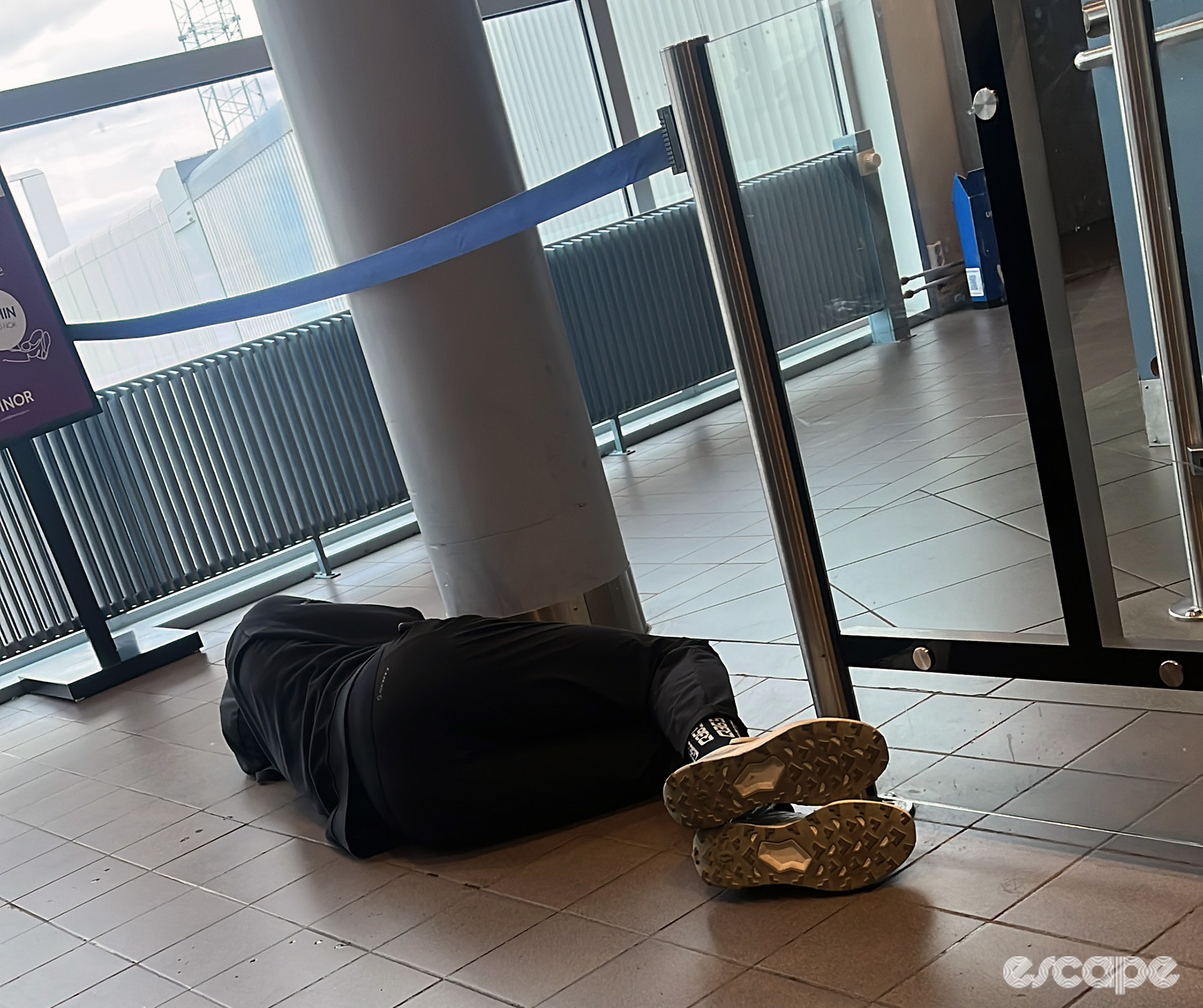
As we board, I watch as Cort picks up a huge backpack and lugs it over his shoulder, his back and legs bending, heaving it onto the plane and into the overhead lockers.
Grøndahl Jansen sits in the aisle seat next to him, opens a book and barely looks up until we’ve landed in Oslo: unplugged from his own personal chaos, choosing his own interlude of quiet joy, unburdened by the noisy vacuum of professional bike racing, which still provides respite from the almighty din of the real world outside.
Did we do a good job with this story?
